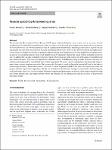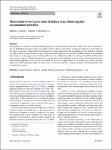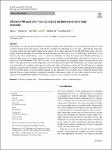Search
Author
- Ackerman, Gary L (1)
- Adrián, Sánchez-Caballero (1)
- Ahmad, Karim (1)
- Ahmed, Eldawy (1)
- next >
Subject
- 2N labeling defense me... (1)
- A primal-dual splittin... (1)
- algorithmic judges (1)
- ANFIS (1)
- next >
Has File(s)
- true (39)
Search Results
In modern computing architectures, graph theory is the soul of the play due to the rising core counts. It is indispensable to keep finding a better way to connect the cores. A novel chordal-ring interconnect topology system, Equality, is revisited in this paper to compare with a few previous works. This paper details the procedures for constructing the Equality interconnects, its special routing procedures, the strategies for selecting a configuration, and evaluating its performance using the open-source cycle-accurate BookSim package. Four scenarios representing small- to large-scale computing facilities are presented to assess the network performance. This work shows that in 16,384-endpoint systems, the Equality network turns out to be the most efficient system. The results also s... |
We introduce the R everse S patial Top-k K eyword (RSK) query, which is defined as: given a query term q, an integer k and a neighborhood size find all the neighborhoods of that size where q is in the top-k most frequent terms among the social posts in those neighborhoods. An obvious approach would be to partition the dataset with a uniform grid structure of a given cell size and identify the cells where this term is in the top-k most frequent keywords. However, this answer would be incomplete since it only checks for neighborhoods that are perfectly aligned with the grid. Furthermore, for every neighborhood (square) that is an answer, we can define infinitely more result neighborhoods by minimally shifting the square without including more posts in it. To address that, we need to i... |
The perception of realism in computer-generated images can be significantly enhanced by subtle visual cues. Among those, one can highlight the presence of dust on synthetic objects, which is often subject to temporal variations in real settings. In this paper, we present a framework for the generation of textures representing the accumulation of this ubiquitous material over time in indoor settings. It employs a physically inspired approach to portray the effects of different levels of accumulated dust roughness on the appearance of substrate surfaces and to modulate these effects according to the different illumination and viewing geometries. The development of its core algorithms was guided by empirical insights and data obtained from observational experiments which are also descr... |
In this work, we study resolvent splitting algorithms for solving composite monotone inclusion problems. The objective of these general problems is finding a zero in the sum of maximally monotone operators composed with linear operators. Our main contribution is establishing the first primal-dual splitting algorithm for composite monotone inclusions with minimal lifting. Specifically, the proposed scheme reduces the dimension of the product space where the underlying fixed point operator is defined, in comparison to other algorithms, without requiring additional evaluations of the resolvent operators. We prove the convergence of this new algorithm and analyze its performance in a problem arising in image deblurring and denoising. |
Incorporating machine learning into automatic performance analysis and tuning tools is a promising path to tackle the increasing heterogeneity of current HPC applications. However, this introduces the need for generating balanced datasets of parallel applications’ executions and for dealing with natural imbalances for optimizing performance parameters. This work proposes a holistic approach that integrates a methodology for building balanced datasets of OpenMP code-region patterns and a way to use such datasets for tuning performance parameters. The methodology uses hardware performance counters to characterize the execution of a given region and correlation analysis to determine whether it covers an unique part of the pattern input space. |
In this paper, we construct multi-key homomorphic and fully homomorphic encryption (resp. MKHE and MKFHE) schemes with malicious circuit privacy. Our schemes are based on learning with errors (LWE) besides appropriate circular security assumptions. In contrast, the previous maliciously circuit-private MKFHE scheme by Chongchitmate and Ostrovsky (PKC, 2017) is based on the non-standard decisional small polynomial ratio (DSPR) assumption with a super-polynomial modulus, besides ring learning with errors and circular security assumptions. We note that it was shown by Albrecht et al. (CRYPTO, 2016) that there exists a sub-exponential time attack against this type of DSPR assumption. The main building block of our maliciously circuit-private MKFHE scheme is a (plain) MKFHE scheme by Brak... |
In this paper, we study the Time-Dependent k Nearest Neighbor (TD-kNN) query on moving objects that aims to return k objects arriving at the query location with the least traveling cost departing at a given time t. Although the kNN query on moving objects has been widely studied in the scenario of the static road network, the TD-kNN query tends to be more complicated and challenging because under the time-dependent road network, the cost of each edge is measured by a cost function rather than a fixed distance value. To tackle such difficulty, we adopt the framework of GLAD and develop an advanced index structure to support efficient fastest travel cost query on time-dependent road network. In particular, we propose the Time-Dependent H2H (TD-H2H) index, which pre-computes the aggreg... |
Many current trackers utilise an appearance model to localise the target object in each frame. However, such approaches often fail when there are similar-looking distractor objects in the surrounding background, meaning that target appearance alone is insufficient for robust tracking. In contrast, humans consider the distractor objects as additional visual cues, in order to infer the position of the target. Inspired by this observation, this paper proposes a novel tracking architecture in which not only is the appearance of the tracked object, but also the appearance of the distractors detected in previous frames, taken into consideration using a form of probabilistic inference known as explaining away. |
In the last years, due to the availability and easy of use of image editing tools, a large amount of fake and altered images have been produced and spread through the media and the Web. A lot of different approaches have been proposed in order to assess the authenticity of an image and in some cases to localize the altered (forged) areas. In this paper, we conduct a survey of some of the most recent image forgery detection methods that are specifically designed upon Deep Learning (DL) techniques, focusing on commonly found copy-move and splicing attacks. DeepFake generated content is also addressed insofar as its application is aimed at images, achieving the same effect as splicing. This survey is especially timely because deep learning powered techniques appear to be the most relev... |
Longest common substring (LCS), longest palindrome substring (LPS), and Ulam distance (UL) are three fundamental string problems that can be classically solved in near linear time. In this work, we present sublinear time quantum algorithms for these problems along with quantum lower bounds. Our results shed light on a very surprising fact: Although the classic solutions for LCS and LPS are almost identical (via suffix trees), their quantum computational complexities are different. While we give an exact O~(n−−√) time algorithm for LPS, we prove that LCS needs at least time Ω~(n2/3) even for 0/1 strings. |









